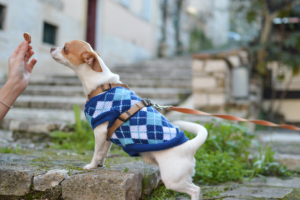Tips to help anxious dogs

Having an anxious dog is a real issue for pet parents, and like humans, when your dog is stressed out they may display physical and mental signs of stress. Unfortunately, sitting them down and asking what’s wrong isn’t an option! So here are our top tips for dealing with an anxious pup.
- Read the signs. When dogs are suffering from anxiety they may display repetitive or destructive behaviours to relieve their stress.
These may include:
- Non-stop barking,
- Chewing furniture/walls/anything else they can get hold of
- Pooping in the house, crate or other confinement areas
- Eating their own poop
- Aggression towards people or other dogs
- Don’t punish your dog
Punishing your dog will not help to stop anxious behaviours in the long-run because punishments do not tackle the source of the stress. Suppressing anxious behaviours through pain and dominance will make the problem worse, because punishments will increase the stress and uncertainty your dog feels.
- Practice desensitisation techniques
If your dog gets stressed in a specific situation then desensitising them to the situation in a calm and controlled environment can reduce their level of stress when the situation arises. For example, if your dog has an anxiety attack every time you clip his nails, get the clippers out and then don’t clip his nails, or work up to touching him with the clippers and leave it at that.
- Practice counter-conditioning
Counter conditioning is a similar behavioural therapy method to desensitisation, but this time as well as simulating a stressful environment you distract your dog with something positive like a treat. Giving your dog treats sends happy hormones to its brain so can reduce the stress in a normally stressful situation.
- Medication
If you’ve tried behavioural methods and sought expert advice from a canine therapist then some dogs respond well to medication. Each dog is different and we would recommend seeking advice from a qualified professional before taking this step.
- Create a calm environment
If you’re panicking, the chances are your dog will be panicking more. Try and remain calm in stressful situations and your dog may find it less stressful. Create a regular routine for your dog and stick to it. Unpredictable situations lead to anxiety so if you can keep your dogs every day routine very predictable they may be generally calmer. Setting a fixed routine for walks, mealtimes, play times, leaving the house and more can help.
We hope that our tips have helped. If your dog continues to show signs of anxiety when you have tried a few different methods of treating the problem then do seek help from a vet or a canine behavioural therapist.

